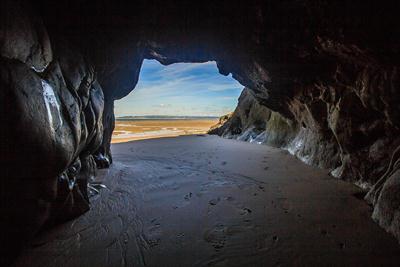PDF chapter test TRY NOW
Erosional Land Forms of Waves
Some of the erosional landforms of sea waves are sea cliff, sea cave, arch, stack, beach, bar and spit and wave-cut platform.Sea cliffs are steep faces of rock and soil that are formed by the erosional activity of waves. These cliffs range from only a few metres high to hundreds of metres above sea level.

Seacliff
A Sea cave or littoral cave is a cave formed in a cliff by wave action. These are formed due to repeated striking action of sea waves on rocks which creates cracks over time, widening the crack to form a cave-like structure.

Sea cave
Sea Arches: Repeated erosion of caves enlarges it to an extent where only the roof is left behind, forming Sea Arches.
Stacks: Sea Arches on erosion loses their roof, leaving behind only the walls. These wall-like structures are called stacks.
WaveCut Platforms Flat surface found at the foot of sea cliffs is called as wave-cut platforms. Wave cut platform is also referred to as wave-cut benches terrace.
Depositional landforms of waves
Beach: A beach is formed when waves deposit sand and gravel along the shoreline.
The first longest beach in the world is the Miami beach in South Florida in the U.S.A. The second longest beach in the world is Marina beach in Chennai.
The first longest beach in the world is the Miami beach in South Florida in the U.S.A. The second longest beach in the world is Marina beach in Chennai.

Sand bar: An elongated, submerged or partially exposed deposit of sand, shingle or mud built up in the water along a shore or beach by sea currents or waves action is called a sand bar. It is also called a shoal or sandbank. It is a deposition of sand or mud found in the sea, almost parallel to the coast.
Spit A spit is an extended ridge or embankment of sediment occurring near a coastal region. One end of the spit is connected to the land, and another end (terminating end) is in open water. Spits are common at the mouth of estuaries. E.g. Kakinada spit
Lagoon: It is a shallow body of water separated from a larger body of water (usually the ocean) by sandbars, barrier islands, or coral reefs. Lagoons are often called estuaries, sounds, bays, or even lakes.
